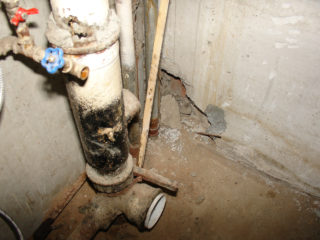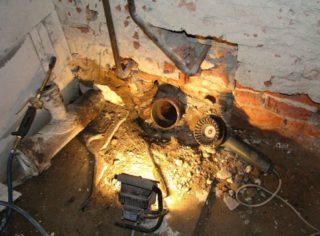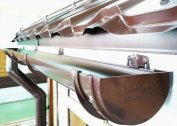In case of emergency or breakthrough of the riser in a multi-storey building, you must contact the management company to replace it. Repair work is free. Responsibilities of housing and communal services for the replacement of sewer risers in an apartment are prescribed in the legislation of Russia. You can refer to specific articles of the Civil Code of the Russian Federation and the rules for using joint municipal property of non-privatized apartments when applying to the management company.
When is a replacement riser required?
As a rule, apartment buildings are equipped with cast-iron risers and water pipes. They are usually over 50-60 years old. During this time, the metal becomes unusable. Fistulas appear on the pipes, leaks are possible. Housing and communal services are required to change the risers in such situations:
- emergency condition of the collector;
- high loads on the wall due to the metal weighted by corrosion;
- pressure on plastic pipes installed below on the first floors or at the top of a neighbor.
It is advisable to change the sewer riser immediately on all floors. So communication will turn out integral from one material.
Who should change the riser in the apartment
Before you go with the application to the Housing Office, and you need to do this without fail, even if you decide to change the pipes yourself, you should familiarize yourself with some excerpts from the rules and laws. They clearly define whose responsibility it is to repair the risers in the houses.
- Article of the Civil Code No. 290 (excerpt). “On the basis of shared ownership rights, homeowners in apartment buildings own sanitary networks inside and outside the premises, serving more than one living space.” That is, the sewer riser on any of the floors (upper / middle / lower) in any case serves several apartments. The collector belongs to the category of common property, which means it is located in the housing and communal services department.
- Government Decision No. 491 of August 13, 2006, Clause 5 (excerpt). “... the public disposal system includes the drainage system in the house / apartment.” That is, the sewer is not directly owned by the owner of the housing.
- Rules for the technical operation of the housing stock (extract). "... included in the ongoing repair including the replacement of the sewer riser in the apartment."
Thus, the management company bears responsibility for the state of water supply / sanitation communication. This is evidenced by the footnote in the invoices for payment of services, in which there is a column "maintenance and repair of the house." Residents with each rent make a contribution to future repairs on common property.
When the owner of the apartment is denied the replacement of pipes
The refusal of the management company to repair the change of the drainage system is justified only if the landlord himself had already carried out any work with the riser or the pipes were deliberately damaged. Regardless of whether the clamps were simply put on the fistulas or the pipe was completely replaced, this must be indicated in the communication inspection certificate. In this case, all repair costs are borne by the owner of the property. The Housing Office only replaces the primary cast-iron riser with plastic, but does not change previously repaired / specially damaged communications.
If the housing and communal services is refused refusal unreasonably, the owner of the apartment must ask for a written refusal.It should state the reasons why the company does not agree to replace the pipes. With this refusal, the owner has the right to go to court or write a complaint to the head of the management company. A request for repair work on the riser must also be in writing. Better - collectively. Then utilities respond faster.
Materials and tools for self-replacement of the riser
If there are independent work to replace communications, prepare the following list of tools and materials:
- pipe cutter or grinder for cutting cast iron;
- a chisel and screwdriver to remove the remnants of old pipes;
- hammer;
- perforator to remove residual cement;
- grinder (for installing cast iron pipes);
- safety glasses and gloves;
- pipes from the selected material;
- silicone fluid sealant and / or sealants;
- tees, crosses, adapters, tap for the toilet;
- compensation pipe, if the polymer / polypropylene pipe is connected at the top with a cast-iron;
- clamps for fixing pipes to the walls;
- vertical level.
Depending on the complexity of the work performed, additional tools in the form of a soldering iron for plastic pipes may be required. It is used when replacing a cast-iron water pipe with a polymer one.
Preparation for dismantling old pipes
Before installing a new riser, you must remove the old communications. For this, it is necessary to carry out a number of preparatory measures:
- Contact the Housing Office to call a locksmith. He must block the water in the riser.
- Notify all neighbors about the inability to use the water supply and sewage system for a certain period of time.
- Remove all unnecessary items in the plumbing room / toilet (furniture, textiles, household chemicals).
- If possible, cover the toilet, sink, and bathtub with an old cloth to avoid contamination with metal crumbs.
During the dismantling of old pipes, they are very neat. It is advisable that two masters work. One should always insure against the accidental fall of old cast-iron pipe pieces.
Stages of work
First of all, they perform the dismantling (analysis) of the old collector. To do this, at a distance of about 20 cm from the floor and ceiling, a horizontal cut is made by a grinder on cast iron. Then hammer part of the collector. From impact load, the cast iron bursts. If the neighbor does not change the riser from the top (a partial replacement of the pipes is carried out), the hole under the ceiling is covered with a film for now. The cut off old pipe is taken out of the apartment and proceed to dismantle the tees.
- It is necessary to loosen the mounting point of the cast-iron branch. The tee is removed with a nail gun or perforator.
- A chisel from the hole removes all cement residues.
- The next step is grinding the edges of the plastic / cast-iron pipe and its subsequent installation.
- The polymer tube is inserted into the hole and parallel with the tee in the floor area.
- All joints are sealed and additionally lubricated with sealant.
- The remaining gaps between the pipes between the ceilings are blown with foam.
The assembled collector is checked for leaks. To do this, flush water from the top floor and from the apartment. If everything is functioning normally, the riser water is opened, and neighbors are notified of the completion of work.
The cost of replacing a sewer riser in an apartment
Costs of repair work:
- If the riser is changed across all floors and by the efforts of the management company, tenants do not owe anything to the craftsmen. Work is free, which means replacing the riser will not cost a dime.
- If the riser is changed in one apartment on their own, the costs are approximately 250-400 rubles. for the purchase of material, depending on its price. The cost of work depends on the type of pipe. If cast iron is installed, and work with welding will have to pay from 15,000 rubles.and higher depending on the region. When working with polymer pipes, masters in Moscow ask from 4,500 rubles.
In accordance with the law, the replacement of communications in the house (water supply, sewage, heating) utilities are required to carry out at least once every 25-30 years. This applies to non-privatized housing.
Intervention in communication networks is a responsible occupation. It can only be carried out with the permission of the management company. It is strictly forbidden to change the location of the riser and its configuration. It is better to invite a professional to carry out repairs. At the end of pipe replacement, it is better to leave access to them through inspection hatches in the form of doors. It will be needed during routine repair or maintenance work at home.






